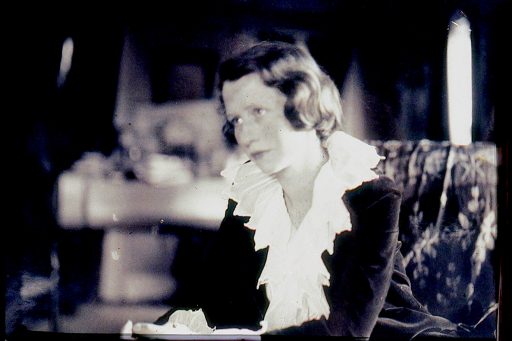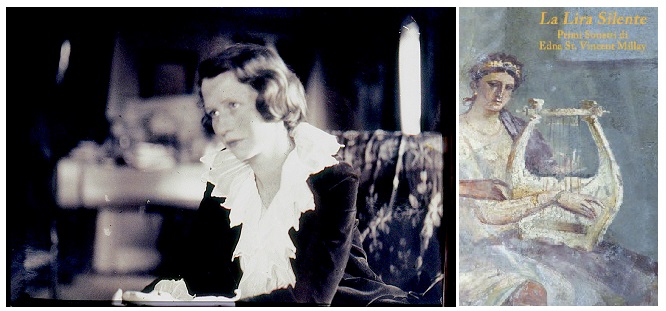In an article regarding Edna St. Vincent Millay that appeared in L’Idea Magazine in January, I mentioned my disappointment that a translator should discuss mainly the poet’s biography and much less the poet’s art—which could be justified by publicity concerns. or by the greater difficulty of discussing the poet’s art. At the same time, I must concede that, in explaining my disappointment with this phenomenon, I too diverged from Millay’s art. In this article, then, I hope to compensate by talking about the forms, theatricality, themes, and archetypes of Millay’s sonnets, which, incidentally, also help to explain her popularity as a poet.
A comment by Thomas Hardy on Millay’s poetry a few years after her Pulitzer win in 1923 has made a big impression; he maintained that America had given the world two attractions, its skyscrapers and Edna St. Vincent Millay’s poetry. Having become a motto, his opinion has nevertheless remained without precise explanation. Hardy was an architect himself and for this reason, the question arises whether by chance he intended to compare Millay’s poetry to skyscrapers! Perhaps, the sonnet could be said to resemble a building with three floors and a ground floor (à la Shakespeare), or with two floors and a ground floor with a high ceiling and mezzanine (à la Petrarch). One might also envision rows of windows and a superstructure that would give unity to the whole—the ground floor, of course, requiring an especially imposing appearance. These similarities are certainly generalized, but some, I would say, are conceivable.
The superstructure that might frame the sonnet would consist of the end rhyme and the regular metric length of the lines. In her sonnets, however, Millay very often uses enjambment and caesuras which have the effect not only of attenuating the impact of the end rhyme but also of extending and varying, if not the line, then the syntax. Therefore, we observe that there is not, as one might expect, a “regular structure,” in her sonnets. The caesuras, especially, break up the lines by introducing pauses at various points. So, unless Hardy was referring to other poems, I doubt he meant to apply an architectural metaphor to Millay’s sonnets.
The syntactic variations achieved with caesuras and enjambments have an effect we tend to overlook that depends on punctuation. It is not only the absence of a period at the end of the line that extends the syntax, but also the presence of a comma, a colon, a semicolon, an em dash, an ellipsis, or what Millay occasionally introduces, a comma, followed by an em dash. With this varied punctuation, observed also in caesuras, the poet indicates pauses of varying lengths— which interpose a variety of psychological and emotional signals. These artistically calculated variations, I believe, can be traced back to Millay’s naturally theatrical bent and her early experience.
We recall that, despite the poverty of the family, Millay’s mother encouraged her daughters in the arts when they were small with books of drama and poetry, a piano, diaries, pens, and opportunities to perform. Later, while acting in high school plays, Millay was recognized by professional companies who, on occasion, invited her to perform with them. At Vassar she wrote plays in which she herself acted, and, during her early years in New York City, was not only tutored in locution by the artist Edith Wynne Matthison, but collaborated with the well-known Provincetown Players as both actress and playwright. At one point, she might well have chosen acting as a career, which, in any case, could not fail to have had an important influence on her art.
It is commonly understood that poetry is to be read either aloud or mentally, with emotions modulated by various pauses that may indicate sighs or reflection at the end of the verse, exclamations, declarations or beckonings at the beginning, second thoughts or ironic comments towards the end, relative calmness at the middle of the line.
Let’s look at a sonnet by Millay that appeared in my previous article:
I know I am but summer to your heart,
And not the full four seasons of the year;
And you must welcome from another part
Such noble moods as are not mine, my dear.
No gracious weight of golden fruits to sell
Have I, nor any wise and wintry thing;
And I have loved you all too long and well
To carry still the high sweet breast of Spring.
Wherefore I say: O love, as summer goes,
I must be gone, steal forth with silent drums,
That you may hail anew the bird and rose
When I come back to you, as summer comes.
Else will you seek, at some not distant time,
Even your summer in another clime.

Here it is noted, among other things, that in the two initial lines as well as in the sixth, the final punctuation marks are not entirely necessary, but obviously, the poet has them at heart. In the ninth line, after “I say,” a comma would suffice, but with a colon, the poet indicates a more resolute pause, and after “goes,” the final comma reinforces the significant beginning of the tenth line. In the penultimate line, the centralizing caesura, by slowing the pace, brings about a sense of resolution.
Another conspicuous parameter in Millay’s sonnets is the use of repetition: of initial words, of syntactically identical phrases, or one and the other in series. With repetition, the emphasis is achieved, which has the effect of heightening the emotion. In the aforementioned poem we note the repetition of “And” at the beginning of lines two, three, and seven, and later also the random repetition in the twelfth line,”I come back” and “summer comes,” as well as, in the first stanzas, negatives like “no,” “no,” and “nor.”
The repetitions and the series, both of single words and phrasal patterns—are clearly noted in the following sonnet:
Mindful of you the sodden earth in spring,
And all the flowers that in the springtime grow,
And dusty roads, and thistles, and the slow
Rising of the round moon, all throats that sing
The summer through, and each departing wing,
And all the nests that the bared branches show,
And all winds that in any weather blow,
And all the storms that the four seasons bring.
You go no more on your exultant feet
Up paths that only mist and morning knew,
Or watch the wind, or listen to the beat
Of a bird’s wings too high in air to view,—
But you were something more than young and sweet
And fair,—and the long year remembers you.
The biography written by Daniel Mark Epstein,* underscores Millay’s theatrical bent. He recounts that when as a teenager she was charged with looking after her younger sisters and her mother worked outside the home, Millay was often very much alone. She wrote faithfully in her diaries, creating scenes in which she interacted with fictional characters. She seems to have made a habit of it, which clearly persisted in her career and in her sonnets.
In the sonnets, characters and settings derived from fairy tales, legends, mythology, chivalric novels, tales from antiquity, and perhaps even from a silent “Roman” film of 1907 appear repeatedly—they are, sum total, archetypal figures. Even the unfolding of the sonnet seems to hark back to Aristotle’s Poetics timeless dramatic pattern, itself archetypal: in the first line, one recognizes from a tone of voice or descriptive details, an inner or external conflict, which the next lines elaborate to a climax, while the last lines offer a dramatic resolution. That is, from the “plot” point of view, the staging, the “characters” and the voices projected, the sonnets have an archetypal air, which can very well explain, together with Millay’s eloquence in public readings, her popularity that continues even today.
In accordance with their dramatic aspects, the sonnets often address a silent but involved listener, or a witnessing spectator. As examples, the following sonnets, the first ** written as a young woman, the second when more mature:
This door you might not open, and you did;
So enter now, and see for what slight thing
You are betrayed… Here is no treasure hid,
No cauldron, no clear crystal mirroring
The sought-for truth, no heads of women slain
For greed like yours, no writhings of distress,
But only what you see… Look yet again—
An empty room, cobwebbed and comfortless.
Yet this alone out of my life I kept
Unto myself, lest any know me quite;
And you did so profane me when you crept
Unto the threshold of this room to-night
That I must never more behold your face.
This now is yours. I seek another place.
Moon, that against the lintel of the west
Your forehead lean until the gate be swung,
Longing to leave the world and be at rest,
Being worn with faring and no longer young,
Do you recall at all the Carian hill
Where worn with loving, loving late you lay,
Halting the sun because you lingered still,
While wondering candles lit the Carian day?
Ah, if indeed this memory to your mind
Recall some sweet employment, pity me,
That with the dawn must leave my love behind,
That even now the dawn’s dim herald see!
I charge you, goddess, in the name of one
You loved as well: endure, hold off the sun.
In my previous article, I mentioned that Millay had some unconventional ideas regarding love relationships, but I believe this topic deserves further comment. While conventional or traditional love relationships tend to require complete fidelity especially from the woman, she is also asked to take a secondary role not only with respect to her mate but to the male-dominated society. Numerous “unconventional” sonnets do nothing more than express Millay’s indignation at these social mores.
Also “unconventionally,” Millay claims the right to deal with any theme in her poetry—often the classic themes traditionally intoned by men, including the aubade, the carpe diem, the ravages of time, death itself, beauty, even the “sublime”—”unconventional” in her case, only because they are addressed by a woman.
Still, I ask myself, is it really the themes that give prominence to Millay’s art, or is it the emotions she arouses in their regard? With the voices, conflicts, pauses, emphases, archetypes, and the Aristotelian arc distilled into sonnet form, Millay instills a variety of emotions in her reader or listener. A review of her sonnets focusing on the emotions they give rise to, would not, I think, deal only with indignation.
* DanielMark Epstein. What lips my lips have kissed.
** This sonnet bears the title “Bluebeard.”
Laura (DiLiberto) Klinkon is Italian-American, a graduate in languages and literature from the University of Pittsburgh in Pennsylvania and the American University in Washington, D.C. Having worked in the editing and translation fields, she retired in 2004, devoting herself to poetry and writing. From 2013 to 2018 she published a volume of her own poems and two chapbooks. In 2018 her first bilingual collection of sonnets by Edna St. Vincent Millay, The Silent Lyre / La Lira Silente appeared, and in 2020, the second volume, Sonnets from Fatal Interview / Sonnets from Colloquio Fatale.
The Italian version of the present article will appear in Atelier Rivista Online.
Edna St. Vincent Millay’s photo and sonnets are republished with the kind permission of Holly Peppe, Literary Executor, The Millay Society (millay.org).







